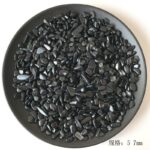Luminescence in Gems: A Mesmerizing Phenomenon
Glow in the dark gems, also known as phosphorescent gems, possess the captivating ability to absorb energy from natural or artificial light sources and emit it back as a luminous glow in the absence of light. This remarkable property, known as luminescence, has captivated humankind for centuries, inspiring awe and wonder.

Phosphorescence is distinct from fluorescence, where gems emit light only while exposed to an excitation source. In contrast, phosphorescent gems continue to emit light for varying durations after the excitation source is removed. This unique characteristic creates an enduring nocturnal glow that can illuminate the darkness with ethereal beauty.
Types of Glow in the Dark Gems
The world of glow in the dark gems encompasses a diverse array of minerals and synthetic materials, each exhibiting its own distinct color and intensity of luminescence. Some of the most well-known phosphorescent gems include:
- Strontium Aluminate: This synthetic material glows a brilliant green and is commonly used in novelty items, such as glow-in-the-dark stars and toys.
- Zinc Sulfide: Another synthetic material, zinc sulfide emits a greenish-yellow glow and is found in glow sticks and luminous paints.
- Yttrium Vanadate: This synthetic gem shines with a vibrant red glow and is used in high-end timepieces and jewelry.
- Calcium Sulfide: This natural mineral glows a bluish-green and is often found in marine sediments.
Applications of Glow in the Dark Gems: Beyond Aesthetics
While glow in the dark gems are undeniably beautiful, their applications extend far beyond mere aesthetic appeal. These luminescent materials play a vital role in various industries, offering a multitude of practical uses:
- Emergency Lighting: Glow in the dark gems are a crucial component of emergency lighting systems. They provide a safe and reliable source of illumination in power outages, evacuation scenarios, and hazardous environments.
- Medical Diagnostics: Phosphorescent gems are employed in medical imaging techniques, allowing for the visualization of internal structures and the detection of anomalies.
- Security Features: The unique glow of these gems makes them ideal for anti-counterfeiting measures and security applications. They can be incorporated into currency, passports, and other sensitive documents as a deterrent against fraud.
- Military Applications: Luminescent materials are utilized in military equipment, such as night vision goggles and target marking devices, enhancing visibility and situational awareness in low-light conditions.
- Decorative Lighting: Glow in the dark gems are a popular choice for decorative lighting, creating an enchanting ambiance in gardens, walkways, and interior spaces.
Market Insights: Glowing Opportunities
The global market for glow in the dark gems is experiencing significant growth, driven by increasing demand from various industries and consumers. According to a report by Grand View Research, the market was valued at USD 1.5 billion in 2022 and is projected to reach USD 2.2 billion by 2030, exhibiting a compound annual growth rate (CAGR) of 4.5%.
This growth is attributed to the rising popularity of glow-in-the-dark products, advancements in material science, and the expansion of applications across industries. The construction, automotive, and healthcare sectors are expected to be major contributors to market growth.
Customer Pain Points: Illuminating the Dark Side
Understanding the pain points of customers is essential for developing and refining glow in the dark gem products that truly meet their needs. Some of the most common challenges faced by customers include:
- Intensity and Duration of Luminescence: Customers desire gems that emit a bright and long-lasting glow, enhancing their functionality and aesthetic appeal.
- Durability and Degradation: The durability and longevity of glow in the dark gems are crucial for applications where they are exposed to harsh conditions or repeated use.
- Environmental Concerns: Customers are increasingly concerned about the environmental impact of glow-in-the-dark materials, seeking sustainable and eco-friendly options.
Addressing these pain points is essential for staying competitive in the market and creating products that meet the evolving needs of customers.
Common Mistakes to Avoid: Shining a Light on Pitfalls
The development and use of glow in the dark gems can be fraught with pitfalls if proper care is not taken. Here are some common mistakes to avoid:
- Overexposing to Light: Excessive exposure to light can deplete the luminescent properties of gems over time, reducing their brightness and longevity.
- Choosing the Wrong Material: Different glow in the dark materials have varying properties and applications. Selecting the appropriate material is crucial for achieving the desired results.
- Ignoring Safety Precautions: Some glow-in-the-dark materials may contain potentially harmful substances. It is essential to follow safety guidelines and handle them with appropriate care.
- Failing to Consider Context: The suitability of glow in the dark gems depends on the specific application and environment. Considering factors such as light sources, exposure durations, and environmental conditions is essential for effective implementation.
Avoiding these mistakes ensures that the use of glow in the dark gems is safe, effective, and produces the desired outcomes.
The Luminescence Lexicon: Deciphering the Glow
To navigate the world of glow in the dark gems, it is essential to familiarize oneself with the key terms and concepts related to luminescence:
- Phosphorescence: The ability of a material to continue emitting light after the excitation source is removed.
- Fluorescence: The emission of light by a material only while exposed to an excitation source.
- Luminescent Intensity: The brightness of the emitted light.
- Luminescent Decay: The rate at which the emitted light fades over time.
- Excitation Spectrum: The range of wavelengths that can excite a material to emit light.
- Emission Spectrum: The range of wavelengths that are emitted by a material after excitation.
Understanding these terms empowers individuals with the knowledge to make informed decisions about glow in the dark gem selection and application.
Brainstorming New Applications: Lighting the Path to Innovation
The fascinating properties of glow in the dark gems inspire endless possibilities for innovation and novel applications. Exploring beyond traditional uses, here are some thought-provoking ideas:
- Self-Illuminating Fabrics: Incorporating glow in the dark materials into textiles could create clothing and accessories that emit a soft glow in the darkness, enhancing safety and visibility.
- Biomedical Sensors: Integrating glow in the dark substances into biomedical devices could enable real-time monitoring of vital parameters, such as heart rate and blood glucose levels, using optical techniques.
- Interactive Displays: Using glow in the dark materials in interactive displays, such as touch screens and virtual reality headsets, could enhance user experience by providing responsive and immersive content.
- Sustainability Solutions: Exploring the use of glow in the dark materials in green energy technologies, such as self-illuminating solar panels or energy-efficient lighting systems, could contribute to a more sustainable future.
Conclusion: Shining a Light on the Future
Glow in the dark gems, with their mesmerizing luminescence and diverse applications, continue to captivate our imaginations and drive innovation. As technology advances and new materials emerge, the potential for these enchanting treasures is bound to expand even further. By embracing the power of luminescence, we can unlock a world of possibilities that illuminate the darkness with wonder and functionality.




























